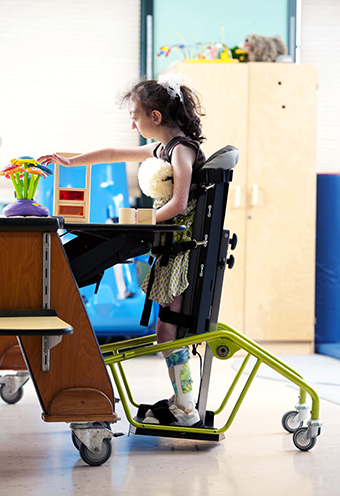Today’s post is the second in a series of articles on the topic of adaptive equipment use in the classroom. Adaptive equipment, used appropriately, serves as a teaching tool for students to learn motor skills such as sitting, standing, and walking, while engaged in the curriculum. This post focuses on standing, including research evidence and tips to promote standing as a motor skill.
Adaptive Equipment for Classrooms Series: Part 1 of 3
Adaptive Equipment for Classrooms Series: Part 3 of 3
The Benefits of Classroom Standing
One of the most valuable pieces of equipment designed for use within a classroom environment is a wheeled or mobile stander. This piece of adaptive equipment enables a child to practice standing in addition to providing mobility so that the child can explore the environment. Manley and Gurtowski describe such a device as a “vertical wheeler ” in their research paper on ambulation abilities in children with cerebral palsy.

Results showed that the children in this cerebral palsy group all benefited from ambulation with the wheeler. Patients with spastic quadriparesis seemed to gain the most immediate benefit. The device contributed to improved mobility, posture and self-image.
The Importance of Weight-Bearing
Standing is important functionally and for maintaining health of many body systems including the bones and joints. If children with severe disabilities are not placed in a standing position frequently, secondary problems such as osteoporosis, soft tissue contractures, and circulatory insufficiency may develop more rapidly. Adaptive equipment should help a student learn skills rather than simply substituting for a lack of standing ability. Appropriately designed standing devices allow the amount of weight-bearing to be adjusted, are usable by children with some degree of hip and knee flexion contractures, and allow the child to push up and lower the weight down repeatedly through a small range. This provision for active weight-bearing is extremely important to allow learning and to build muscle strength in the lower extremities.
Dosing Recommendations
 Wayne Stuberg’s excellent review article on standing programs for children with disabilities includes several important recommendations. He recommends that non-ambulatory children with disabilities be placed in standing for 60 minutes a day, 4 or 5 days a week for bone development and to control contractures. Stuberg also says, “Intermittent loading appears to be a key stimulus during standing, as opposed to increasing the time of a static program.” In a properly designed adaptive mobile stander, the child is able to perform intermittent loading through the lower extremities, exercising the hip and knee extensors and elongating the hip and knee flexors.
Wayne Stuberg’s excellent review article on standing programs for children with disabilities includes several important recommendations. He recommends that non-ambulatory children with disabilities be placed in standing for 60 minutes a day, 4 or 5 days a week for bone development and to control contractures. Stuberg also says, “Intermittent loading appears to be a key stimulus during standing, as opposed to increasing the time of a static program.” In a properly designed adaptive mobile stander, the child is able to perform intermittent loading through the lower extremities, exercising the hip and knee extensors and elongating the hip and knee flexors.
Positioning & Peer Interactions
The MOVE program, an activity-based curriculum for children and adults with disabilities noticed in an initial pilot program that peer interactions increased dramatically when the children were supported in a standing position. This curriculum recommends the use of adaptive equipment that places the child in a slightly forward-leaning supported standing position as this allows easier head control and frees the upper extremities for functional activities. A well-designed stander should allow the degree of weight-bearing to be adjusted from non-weight-bearing to full weight-bearing. A mobile stander with large wheels can allow some non-ambulatory students to experience independent mobility by wheeling the stander around. Some standers incorporate forearm prompts to allow the more severely involved children to work on developing head control.
The Key Features for Standing Effectiveness
To summarize, features that are important for equipment to support standing include:
- Positioning that encourages forward-leaning or “prone standing”
- Adjustability to allow weight-bearing to be adjusted from zero to full weight-bearing.
- Accommodation for lower extremity contractures (Note: Severe flexion contractures may prevent supported standing.)
- Optional forearm prompts or other upper extremity support.
- Ability to reduce the height of the trunk support as the child gains trunk control.
- Mobility (not absolutely essential for teaching standing, but a very important feature.)
Bear in mind that standing skills are best taught by gradually reducing the amount of support the adaptive equipment provides as the child gains strength and control.  The general sequence for reducing support is described as follows: “Typically, we help the students improve head control while standing with a mobile stander. The student is then encouraged to bear full weight on the feet by adjusting the strapping mechanism. As the student can maintain trunk control while standing, the body support is lowered.” (Bidabe, 1999)
The general sequence for reducing support is described as follows: “Typically, we help the students improve head control while standing with a mobile stander. The student is then encouraged to bear full weight on the feet by adjusting the strapping mechanism. As the student can maintain trunk control while standing, the body support is lowered.” (Bidabe, 1999)
Learning the skill of standing also involves practicing transitional movements such as sit-to-stand and stand-to-sit. These skills are important in themselves and they also build muscle strength and control in both concentric and eccentric modes and provide an excellent foundation for teaching ambulation skills within the classroom environment. Check back in a week for the next post of the sequence: The Role of Ambulation in an Educational Environment.
Adaptive Equipment for Classrooms Series: Part 1 of 3
Adaptive Equipment for Classrooms Series: Part 3 of 3
Back to Top